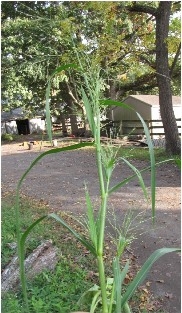Fall Panicum Toxicity In Horses
ID
APSC-116NP
Fall Panicum is a common annual warm season grass that can be hepatotoxic (cause liver disease) in horses under certain growing conditions. Toxicity in horses was documented in Virginia in 2004 when fourteen horses were diagnosed with liver disease as a result of consuming Fall Panicum hay. Currently, there have been several cases of suspected toxicity in horses grazing Fall Panicum in Northern Virginia pastures since late summer 2015. The trigger that causes toxicity and the amount of grass required to cause illness are not well understood, thus proper identification and treatment are essential for recovery.

Identification
Fall Panicum (Panicum dichotomiflorum) is a fibrous rooted warm season annual grass that grows 3 to 6 feet tall, although size varies greatly depending on growing conditions. It reproduces from seeds and is relatively easy to identify in the late summer and fall when it's distinct wispy pyramid shaped seed heads are present. The stem has a unique "zigzag" appearance where it bends and leaves emerge alternately from the joints (nodes). The leaves are ½ to 1" wide and 6 to 18" long in mature plants and usually smooth, but may be sparsely hairy.
Toxicity
Steroidal saponins cause liver disease within two weeks of consumption.
Symptoms
- Decreased appetite
- Lethargy
- Somnolence (unusual periods of sleepiness)
- Mild colic
- Neurological signs
- Some horses may show no symptoms at all
Diagnosis
History of exposure and/or multiple horses on a farm or geographic region may be indicative of Fall Panicum toxicity. Blood analyses reveal abnormally high gamma glutamyl transferase (GGT), aspartate aminotransferase (AST), sorbitol dehydrogenase (SDH), and alkaline phosphatase (ALP), as well as increased concentrations of serum bile acids and bilirubin. Pyrrolizidine alkaloidosis (ragwort toxicity) results in similar laboratory findings.
Treatment
Immediate removal of Fall Panicum from the diet results in good prognosis for acute exposure. Horses with severe liver disease may not recover. Survival appears to be greatly improved with early detection. Supportive care can be lengthy.
If you suspect you have Fall Panicum in your pasture or hay it is advisable to contact your veterinarian to test for liver disease. If any one horse on a property has liver disease, testing asymptomatic horses is advisable. For assistance with plant identification and controlling Fall Panicum, please contact your County Extension agent.
Virginia Cooperative Extension materials are available for public use, reprint, or citation without further permission, provided the use includes credit to the author and to Virginia Cooperative Extension, Virginia Tech, and Virginia State University.
Virginia Cooperative Extension is a partnership of Virginia Tech, Virginia State University, the U.S. Department of Agriculture (USDA), and local governments, and is an equal opportunity employer. For the full non-discrimination statement, please visit ext.vt.edu/accessibility.
Publication Date
October 14, 2020



